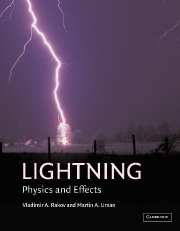Book contents
- Frontmatter
- Contents
- Preface
- 1 Introduction
- 2 Incidence of lightning
- 3 Electrical structure of lightning-producing clouds
- 4 Downward negative lightning discharges to ground
- 5 Positive and bipolar lightning discharges to ground
- 6 Upward lightning initiated by ground-based objects
- 7 Artificial initiation (triggering) of lightning by ground-based activity
- 8 Winter lightning in Japan
- 9 Cloud discharges
- 10 Lightning and airborne vehicles
- 11 Thunder
- 12 Modeling of lightning processes
- 13 The distant lightning electromagnetic environment: atmospherics, Schumann resonances, and whistlers
- 14 Lightning effects in the middle and upper atmosphere
- 15 Lightning effects on the chemistry of the atmosphere
- 16 Extraterrestrial lightning
- 17 Lightning locating systems
- 18 Deleterious effects of lightning and protective techniques
- 19 Lightning hazards to humans and animals
- 20 Ball lightning, bead lightning, and other unusual discharges
- Appendix: Books on lightning and related subjects
- Index
15 - Lightning effects on the chemistry of the atmosphere
Published online by Cambridge University Press: 05 June 2013
- Frontmatter
- Contents
- Preface
- 1 Introduction
- 2 Incidence of lightning
- 3 Electrical structure of lightning-producing clouds
- 4 Downward negative lightning discharges to ground
- 5 Positive and bipolar lightning discharges to ground
- 6 Upward lightning initiated by ground-based objects
- 7 Artificial initiation (triggering) of lightning by ground-based activity
- 8 Winter lightning in Japan
- 9 Cloud discharges
- 10 Lightning and airborne vehicles
- 11 Thunder
- 12 Modeling of lightning processes
- 13 The distant lightning electromagnetic environment: atmospherics, Schumann resonances, and whistlers
- 14 Lightning effects in the middle and upper atmosphere
- 15 Lightning effects on the chemistry of the atmosphere
- 16 Extraterrestrial lightning
- 17 Lightning locating systems
- 18 Deleterious effects of lightning and protective techniques
- 19 Lightning hazards to humans and animals
- 20 Ball lightning, bead lightning, and other unusual discharges
- Appendix: Books on lightning and related subjects
- Index
Summary
… it will be necessary to learn much more about the physics of lightning and its global occurrence before it will be possible to assess accurately its importance as a source of nitrogen oxides.
B. Vonnegut (1982)Introduction
The Earth's atmosphere below about 80–90 km, the height above which significant ionization occurs (subsection 13.2.1 and Fig. 13.5), is composed of about 21 percent molecular oxygen, O2, about 78 percent molecular nitrogen, N2, and small percentages of carbon dioxide, CO2, molecular hydrogen, H2, argon, Ar, and other noble gases, and water vapor, H2O. Both the pressure and density of the atmosphere decrease approximately exponentially with altitude, with a decay height of about 10 km for all constituents of the air except water vapor. The water vapor content decreases more rapidly with height. The overall pressure at an altitude of 15 km is about one-tenth that at the surface, at 30 km about one-hundredth, and at 50 km near one-thousandth.
Different regions of the atmosphere have been given different names, based on the characteristics of their temperature profiles, as illustrated in Fig. 14.1. Adjacent to the Earth's troposphere, in which the temperature decreases with height. The troposphere is often called the lower atmosphere. In the mid-latitudes the troposphere extends from the is typically near 300 K, to the tropopause, near 15 km, where the temperature in the summer is just above 200 K, although the jet stream can produce a discontinuity in the tropopause leading to a double tropopause. In the tropics the tropopause is a few kilometers higher and 10 to 20 K colder than in temperate regions. The tropopause is also discussed in Section 3.1.
- Type
- Chapter
- Information
- LightningPhysics and Effects, pp. 507 - 527Publisher: Cambridge University PressPrint publication year: 2003
- 3
- Cited by



